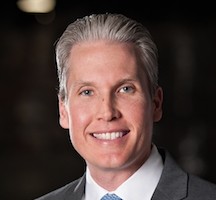Gulf region drayage grappling with exciting, complex times
A retail supply chain shift following Panama Canal expansion and the emergence of production of petrochemical resins for export are among factors presenting challenges for the container drayage business in the Gulf region, according to the head of a major Houston-based drayage provider.
“These are exciting and complex times in the Gulf region drayage business,” Todd Stewart, president of Gulf Winds International Inc., told AJOT, noting that his firm, which moves containers in the markets of Houston and Dallas in Texas, as well as Mobile, Alabama, continues to see rising cargo volumes, including record activity at Port Houston.

facing challenges related to supply chain shifts and strong exports of petrochemical resins.
Increasingly, following the mid-2016 completion of the Panama Canal expansion project, imports from Asia that traditionally might have come into Southern California containerports and been railed to Dallas-Fort Worth hubs for distribution are instead coming on large boxships directly into Houston and sometimes other Gulf Coast ports, he pointed out.
Stewart also cited the billions of dollars of investments in the Gulf region, particularly along the Houston Ship Channel, by petrochemical companies in new production of plastic resins for export, as the United States has emerged as the world’s leading low-cost producer of that product thanks to the region’s ample availability of affordable natural gas. That production is now coming more fully online following delays precipitated by Hurricane Harvey in late summer 2017 and other factors.
“The vast majority of it is being shipped out of Houston, and we think that will obviously continue for many years to come, which is exciting for our markets,” said Stewart, who has been with Gulf Winds since 1996.
“This has created a market dynamic that has reduced ocean rates into Houston and has allowed for some of those imports to shift from Dallas to Houston, which has also allowed some of the big retailers to open in proximity to Port Houston,” he said, adding that, with its superb rail infrastructure, Dallas still remains a significant distribution hub.
Part of the challenge revolves around ensuring a sufficient number of import containers coming into Houston are then available for exporting resins.
One way in which larger providers, such as Gulf Winds, address such concerns is by having their own chassis fleets. In the case of Gulf Winds, that means operating 1,000 of its own chassis.
“Sometimes we lease, sometimes we own, but we definitely don’t want to be at the mercy of the marketplace as it relates to chassis,” Stewart said. “It obviously also helps the driver if you’re providing equipment to them, because it means less stops for them and allows them to make more money as far as the owner-operator goes.”
At a time of shortage of qualified commercial truck drivers, Gulf Winds also maintains a major focus on driver recruitment and retention. This includes communicating with drivers related to not just day-to-day matters but also broader supply chain trends, such as the artificial bubble created by the recent rush of importers to get in goods in advance of tariff implementations.
“It’s a big issue for the whole industry, not just in Texas but around the country,” Stewart said. “We certainly need to continue to see rates move upward, and the opportunity to provide increases in pay for the driver is obviously something that’s necessary, but really it’s about efficiency and allowing them to make a living.
“If we can create efficiencies in the chain by providing good equipment, then there are opportunities for them to make more turns and take home more pay,” he continued, noting that Gulf Winds has about 400 owner-operators driving for the company. “The other big piece is making sure that they’re home every night and have an opportunity to be with their families.”
Specific to Texas, Stewart cited recently passed state legislation that has created opportunities to move larger loads over the road under specific conditions within a 30-mile radius of port terminals. Gulf Winds has invested in specialized equipment to accommodate such heavier loads and offers its gwiMAX product, an overweight program that can help shippers of resins and other goods reduce ocean freight costs by as much as 20 percent.

Regarding the industry challenges posed by congestion, Stewart commended Port Houston for its investments to alleviate logjams within its gates, but, he said, “More and more we have to focus on the infrastructure outside the gates.
“One downside that impacts everything and people don’t talk about a lot is that the larger vessels do provide great economies of scale for shippers on the import side and the export side,” Stewart said, “but, when you’re on the landside transportation – and we also operate transload facilities as well – it all comes at once now as opposed to being spread out.
“So that makes it a little more difficult when you’re planning labor and driver availability, all the things that go along with shoving more through the chain in a shorter time,” he added. “It might be the same amount, but it creates more of a bubble that’s harder to manage, even from a rail perspective at an inland port like Dallas where mass bunching that can occur.”
Comprehensive coverage of Gulf Coast ports and trade, including reports on more than 20 ports of the region, is slated to appear in the March 25 print edition of AJOT.
© Copyright 1999–2024 American Journal of Transportation. All Rights Reserved


